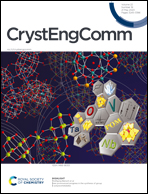Enhanced near-infrared luminescence in Ln2Cd2 (Ln = Nd, Yb) heterotetranuclear complexes†
Abstract
The syntheses of highly efficient NIR-emitting lanthanide complexes are challenging due to the lack of an effective strategy that can both simultaneously suppress the nonradiative transition caused by high energy oscillators and enhance the sensitization efficiency. Herein, a ditopic rigid Schiff base, N,N′-bis(2-oxy-3-methoxybenzylidene)-1,4-phenylenediamine (H2L), with p-phenylenediamine as a spacer was designed, which self-assembled with the Cd2+ and Ln3+ ions and TTA (2-thenoyltrifluoroacetone) forming tetranuclear Cd–Ln complexes, Ln2Cd2L2(TTA)4(OAc)2(CH3OH)2 (Ln = Nd (1), Yb (2) and La (3)). X-ray crystallographic analysis revealed that complex 1 adopted a double-stranded tetranuclear structure, in which the two heteronuclear Cd–Nd units were linked together by phenylene, and each Nd(III) ion was nine-coordinated by four oxygen atoms from two L, four oxygen atoms from TTA and one oxygen atom from an acetate anion. The photophysical studies demonstrated that the helicates showed excellent NIR luminescence with the luminescence quantum yields reaching 0.34% for Nd3+ and 2.13% for Yb3+ in CH3CN. The high NIR luminescence quantum yields benefit from the rigid structure of the complexes and the synergistic interactions between two ligands. Additionally, the large π-conjugating system of H2L makes the absorption edge of the complexes extend to the 450 nm blue light region, which makes the complexes suitable for biomedical applications.



 Please wait while we load your content...
Please wait while we load your content...